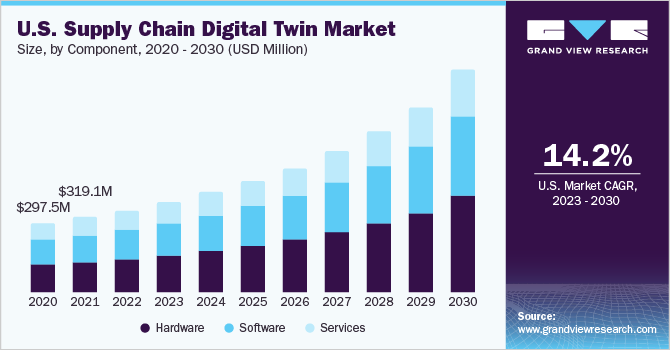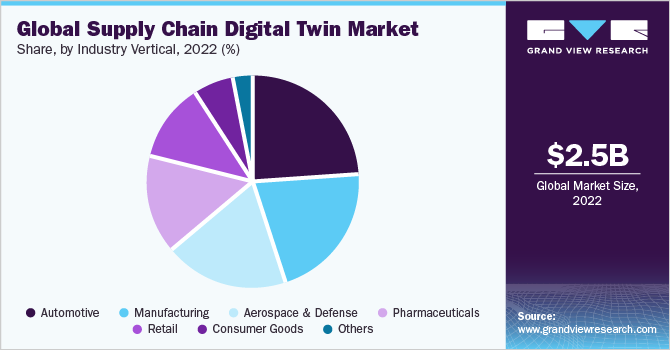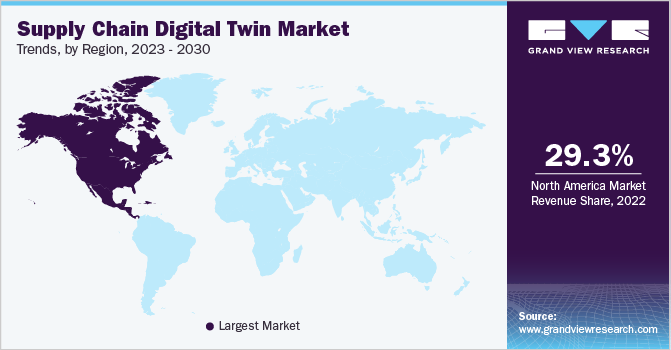- Home
- »
- Next Generation Technologies
- »
-
Supply Chain Digital Twin Market Size & Share Report, 2030GVR Report cover
![Supply Chain Digital Twin Market Size, Share & Trends Report]()
Supply Chain Digital Twin Market Size, Share & Trends Analysis Report By Component, By Deployment Mode (On-premise, Cloud), By Enterprise Size, By Industry Vertical, By Region, And Segment Forecasts, 2023 - 2030
- Report ID: GVR-4-68040-128-5
- Number of Report Pages: 110
- Format: PDF, Horizon Databook
- Historical Range: 2017 - 2021
- Forecast Period: 2023 - 2030
- Industry: Technology
Report Overview
The global supply chain digital twin market size was valued at USD 2.49 billion in 2022 and is expected to grow at a compound annual growth rate (CAGR) of 12.0% from 2023 to 2030. The market is expected to be driven by the proliferation of Internet of Things (IoT) devices and sensors along the supply chain, creating massive volumes of data. A digital twin can use this data to generate precise models, provide information about real-time operations, and allow predictive analytics for better decision-making. In addition, incorporating advanced analytics and artificial intelligence into a supply chain digital twin improves its capabilities. Machine learning algorithms can forecast demand variations, adjust inventory levels, and recommend the best transit routes, increasing total efficiency.

A supply chain digital twin is a virtual representation that emulates the real-world supply chain. It serves as a tool to analyze the dynamics of the supply chain and predict the outcomes of various processes. By incorporating real-time insights and capturing planned and active work orders, sales orders, pending approvals, demand, and inventory information, these digital twin models are enhanced. This technology plays a pivotal role in the manufacturing sector's digital transformation, enhancing operational efficiency, increasing revenue, and elevating customer satisfaction. Supply chain analysts can also leverage digital twin technology to drive their businesses' digital evolution, achieving streamlined processes and high-level automation.
Furthermore, digital twins provide a comprehensive and ongoing view of supply chain operations and bottlenecks, facilitating swift issue resolution with minimal human intervention. These excel at identifying potential shortcomings across all delivery stages through data collection. For instance, a shipment digital twin leverages sensor data to relay real-time information throughout the shipment process. This data is then analyzed to pinpoint performance metrics and obstacles during the transportation and delivery phase.
In addition, digital twins can effectively manage the intricate interplay of external and internal components within end-to-end supply chains. They are adept at establishing intricate nonlinear models of supply chains. An inherent advantage lies in their capacity to run numerous hypothetical scenarios, allowing the technology to learn and grow from these assessments over time. This equips managers to arrive at quicker, more accurate, and well-informed decisions with significant long-term implications, all at a notably reduced cost. Functioning as keen observers, these solutions gather real-time data through a network of sensors, evolving through continuous learning from this data and its contextual insights. This dynamic evolution involves interactions with humans, devices, and other interconnected digital twins.
COVID-19 Impact
The COVID-19 pandemic has significantly impacted the global economy, affecting many industries and markets. The supply chain digital twin market is no exception, and the pandemic has caused several changes and disruptions in this industry. The epidemic exposed flaws in global supply systems, prompting businesses to prioritize resilience and risk management. Supply chain digital twins have gained popularity as tools for simulating and modeling various scenarios, assisting businesses in identifying potential risks, optimizing tactics, and improving overall supply chain resilience.
Moreover, due to the pandemic, there was an increased requirement for real-time visibility into supply chain activities due to rapid variations in inventory and logistics. These solutions provided a virtual platform for monitoring and managing interruptions, allowing businesses to make swift, informed decisions. Companies realized the value of technologies such as digital twins in adapting to changing market conditions, optimizing processes, and enabling distant cooperation.
Component Insights
Based on component, the market is classified into hardware, software, and services. The hardware segment dominated with a revenue share of 42.0% in 2022. The ongoing advancements in hardware technologies, such as encompassing sensors, the Internet of Things (IoT), and edge computing devices, propel the integration of hardware components in the supply chain digital twin sector. These progressions empower real-time data collection and enable seamless network connectivity and integration with digital twin systems. Notably, these hardware components assume a pivotal function in establishing connections between digital twin models and the tangible assets present within the supply chain.
The software segment is expected to emerge with a significant CAGR of 12.3% over the forecast period. The demand for predictive maintenance and optimization in supply chain management drives the software segment. Real-time data can be simulated and analyzed using digital twin software to identify probable equipment problems, optimize maintenance schedules, and increase overall operational efficiency. Furthermore, players such as IBM offer Maximo Application Suite, which is a collection of software for asset management, asset monitoring, predictive maintenance, and reliability planning.
Deployment Mode Insights
Based on deployment mode, the market is classified into on-premises and cloud. The on-premise segment held the largest revenue share of 52.1% in 2022. The handling of sensitive data in the supply chain drives the on-premises segment. Defense, aerospace, and healthcare industries may deal with sensitive information that requires strict control and confidentiality. Furthermore, the on-premises solutions provide more data protection for such industries. In addition, the on-premises deployment mode helps maintain full control and ownership of their supply chain data. Keeping data on-premise allows organizations to establish their data governance policies and procedures.
The cloud segment is expected to witness the fastest CAGR of 12.7% over the forecast period. Cloud-based deployment provides scalability and flexibility, allowing organizations to adjust their resources and capacity based on demand easily. This is particularly beneficial in supply chain operations that may experience fluctuations in volume and complexity. Key players engage in collaborations to offer supply chain digital twin solutions. For instance, in October 2022, Capgemini and Microsoft joined forces to introduce ReflectIoD, an innovative cloud-native digital twin platform hosted on Azure. This pioneering platform operates in a serverless environment, boasting heightened security and scalability. By harnessing the capabilities of Azure's premier architecture and technology offerings, ReflectIoD aims to revolutionize operational and maintenance efficiency for organizations. It facilitates intelligent industry practices and cultivates enduring business value through sustainable means.
Enterprise Size Insights
Based on enterprise size, the market is classified into large enterprises and small and medium-size enterprises. The large enterprises segment dominated with the largest revenue share of 65.7% in 2022 and is projected to retain its dominance over the forecast period. Large enterprises often have complex supply chains involving multiple suppliers, manufacturers, distributors, and customers. Implementing digital twin solutions allows these organizations to gain better visibility and control over their supply chain operations, improving efficiency and cost savings. Moreover, large organizations have more resources, both financially and in terms of IT infrastructure. This allows them to invest in and adopt digital twin solutions on a greater scale, leveraging their resources to drive supply chain innovation and optimization.
The small & medium enterprises (SMEs) segment held a considerable revenue share of 34.3% in 2022. Small businesses confront fierce market rivalry. Adopting digital twin solutions can give small businesses a competitive advantage by boosting supply chain efficiency, lowering costs, and increasing customer satisfaction. Moreover, SMEs may face regulatory requirements related to their supply chain operations. Such solutions that offer compliance management features can assist small enterprises in meeting regulatory standards and ensuring adherence to industry-specific regulations.
Industry Vertical Insights
Based on industry vertical, the market is classified intomanufacturing, automotive, aerospace and defense, retail, pharmaceuticals, consumer goods, and others. The automotive segment accounted for a dominant revenue share of 24.0% in 2022 and is projected to retain its dominance over the forecast period. The automotive industry requires real-time insights into supply chain operations to ensure timely delivery of parts and components, manage inventory levels, and address disruptions. These solutions enable automotive firms to make data-driven decisions and respond swiftly to changing market conditions through real-time monitoring, predictive analytics, and scenario modeling.
The manufacturing segment held a considerable revenue share of 20.5% in the year 2022. The segment is expected to be driven by factors such as cost reduction and efficiency, supply chain visibility and optimization, quality control and product innovation, predictive maintenance and equipment optimization, sustainability and environmental impact, collaboration and integration, and regulatory compliance. These factors contribute to improving manufacturing processes, reducing costs, enhancing product quality, and driving overall supply chain performance.

The manufacturing segment held a considerable revenue share of 20.5% in the year 2022. The segment is expected to be driven by factors such as cost reduction and efficiency, supply chain visibility and optimization, quality control and product innovation, predictive maintenance and equipment optimization, sustainability and environmental impact, collaboration and integration, and regulatory compliance. These factors contribute to improving manufacturing processes, reducing costs, enhancing product quality, and driving overall supply chain performance.
Regional Insights
North America led the overall market in 2022, with a revenue share of 29.3% in 2022. The regional growth can be attributed to the integration of advanced technologies and the proliferation of IoT devices, particularly in industries such as defense & aerospace, manufacturing, logistics & transport, healthcare, and manufacturing. Furthermore, the presence of digital twin solution providers for supply chains such as IBM, Ansys, Inc., and Microsoft, and the rising adoption of digital transformation technologies by industrial verticals to achieve better visibility, accurate predictions, faster time-to-market, improved customer satisfaction, and enhanced product quality, among others, are further fueling the growth of the market in this region.

Europe is anticipated to grow at a considerable CAGR of 12.4% throughout the forecast period. Favorable government policies, increased funding for research and development (R&D), and the standardization of technology across regions are anticipated to boost market growth over the forecast period. For example, the European Digital Twin (EDT) project is a collaborative initiative by the European Union (EU) and the European Association of National Metrology Institutes (EURAMET) to promote the use of digital twin technology across different sectors. The project aims to establish a European-wide framework for digital twin technology, including standardization, certification, and testing.
Key Companies & Market Share Insights
The market is consolidated and is anticipated to witness limited competition owing to major players capturing most of the share. Furthermore, key startups such as Kinaxis, The AnyLogic Company, and Simio choose to target specific niches or verticals within the supply chain industry. By focusing on a particular industry segment, such as automotive, pharmaceuticals, or retail, these startups can develop tailored digital twin solutions that cater to that industry's specific needs and requirements.
However, major players spend heavily on partnerships and collaboration to integrate advanced technologies in Supply Chain Digital Twin. For instance, in October 2022, SAP SE announced a partnership with Boston Consulting Group. The collaboration was aimed at studying the idea of a "digital financial twin,” a virtual representation of financial and some non-financial metrics that assess relationships, structures, and processes throughout a product's lifecycle and value chain by accurately assigning metrics to different elements, such as products, services, suppliers, customers, and employees.
These industry participants actively engage in strategic endeavors, including mergers and acquisitions, and introduce new products to fortify their market position. These initiatives aim to secure a substantial market share and enhance overall profitability. Some prominent players in the global supply chain digital twin market include:
-
IBM
-
Oracle
-
SAP
-
Dassault Systèmes
-
AVEVA
-
Siemens Digital Industries Software
-
Kinaxis
-
The AnyLogic Company
-
Simio
-
Logivations
Supply Chain Digital Twin Market Report Scope
Report Attribute
Details
Market size value in 2023
USD 2.71 billion
Revenue forecast in 2030
USD 5.98 billion
Growth rate
CAGR of 12.0% from 2023 to 2030
Base year for estimation
2022
Historic year
2017 - 2021
Forecast period
2023 - 2030
Quantitative units
Revenue in USD million/billion and CAGR from 2023 to 2030
Report coverage
Revenue forecast, company ranking, competitive landscape, growth factors, and trends
Segments covered
Component, deployment mode, enterprise size, industry vertical, region
Regional scope
North America; Europe; Asia-Pacific; Latin America; Middle East & Africa
Country scope
U.S.; Canada; U.K.; Germany; France; China; India; Japan; Taiwan; Brazil; Mexico; United Arab Emirates (UAE); Kingdom of Saudi Arabia (KSA); South Africa
Key companies profiled
IBM; Oracle; SAP; Dassault Systèmes; AVEVA; Siemens Digital Industries Software; Kinaxis; The AnyLogic Company; Simio; Logivations
Customization scope
Free report customization (equivalent up to 8 analysts working days) with purchase. Addition or alteration to country, regional & segment scope.
Pricing and purchase options
Avail customized purchase options to meet your exact research needs. Explore purchase options
Global Supply Chain Digital Twin Market Segmentation
This report forecasts market revenue growths at global, regional, as well as at country levels and offers an analysis of the qualitative and quantitative market trends in each of the sub-segments from 2017 to 2030. For this report, Grand View Research has segmented the global supply chain digital twin market report based on component, deployment mode, enterprise size, industry vertical, and region:
-
Component Outlook (Revenue, USD Million, 2017 - 2030)
-
Hardware
-
Software
-
Services
-
-
Deployment Mode Outlook (Revenue, USD Million, 2017 - 2030)
-
On-premise
-
Cloud
-
-
Enterprise Size Outlook (Revenue, USD Million, 2017 - 2030)
-
Large Enterprises
-
Small and Medium Size Enterprises (SMEs)
-
-
Vertical Outlook (Revenue, USD Million, 2017 - 2030)
-
Manufacturing
-
Automotive
-
Aerospace and Defense
-
Retail
-
Pharmaceuticals
-
Consumer Goods
-
Others
-
-
Regional Outlook (Revenue, USD Million, 2017 - 2030)
-
North America
-
U.S.
-
Canada
-
-
Europe
-
Germany
-
U.K.
-
France
-
-
Asia-Pacific
-
China
-
India
-
Japan
-
-
Latin America
-
Brazil
-
Mexico
-
-
Middle East & Africa
-
United Arab Emirates (UAE)
-
Kingdom of Saudi Arabia (KSA)
-
South Africa
-
-
Frequently Asked Questions About This Report
b. The global supply chain digital twin market size was estimated at USD 2.49 billion in 2022 and is expected to reach USD 2.71 billion in 2023.
b. The global supply chain digital twin market is expected to grow at a compound annual growth rate of 12.0% from 2023 to 2030 to reach USD 5.98 billion by 2030.
b. North America led the overall market in 2022 gaining a market share of 29.3%, with the U.S. being a major contributor to the industry. High penetration of digital technology is one of the factors propelling the market growth of the North American supply chain digital twin market.
b. Some of the key player include IBM, SAP, Oracle, Datumix, Cognition Factory, Logivations, Dassault Systèmes, Siemens Digital Industries Software, AVEVA, and Resilinc.
b. Digital twin adoption has been fueled by the industry's rapid growth and the demand for cutting-edge technology. This technology enables better monitoring, analysis, and operation optimization by providing a complete and real-time picture of the whole supply chain.
Share this report with your colleague or friend.
![gvr icn]()
NEED A CUSTOM REPORT?
We can customize every report - free of charge - including purchasing stand-alone sections or country-level reports, as well as offer affordable discounts for start-ups & universities. Contact us now
![Certified Icon]()
We are GDPR and CCPA compliant! Your transaction & personal information is safe and secure. For more details, please read our privacy policy.
We are committed towards customer satisfaction, and quality service.
"The quality of research they have done for us has been excellent."





